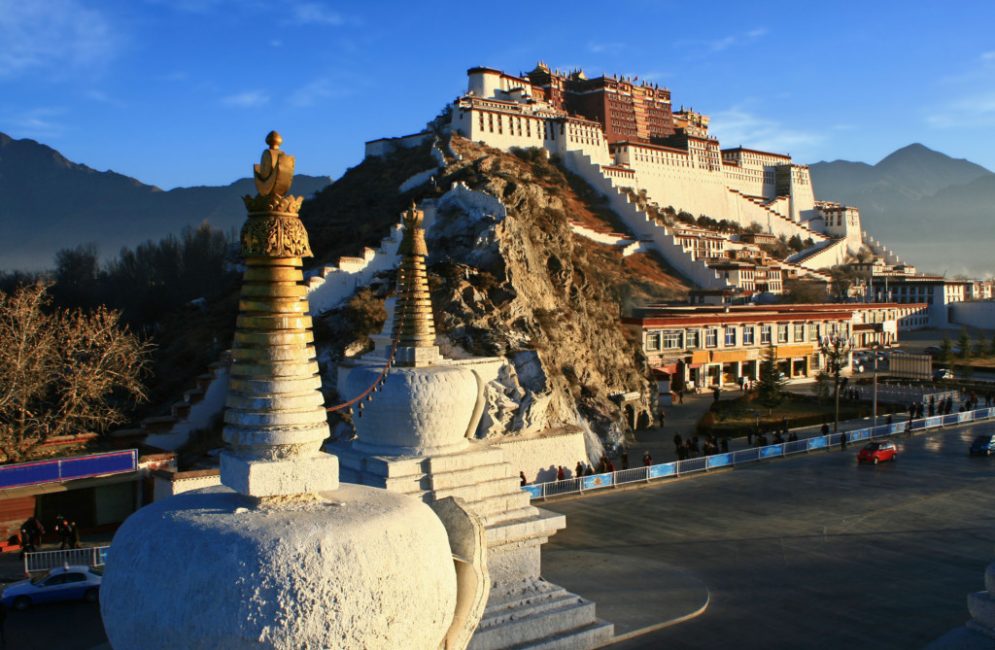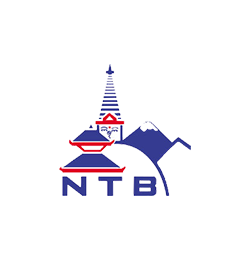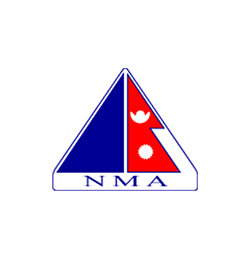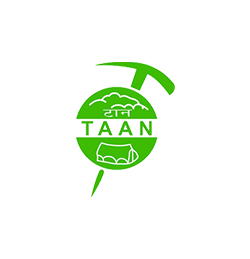
Lhasa / Tibet Tour
Best season for Lhasa and Tibet Tour from April to November months of the year, as it includes wet monsoon times of June to August also, as Tibet falls within rain-shadow area.
Where monsoon heavy dark clouds blocked by Himalayan range of mountains, which makes Tibet a dry and arid country with few greens pasture for yak and other cattle’s to graze.
April and May of spring times with lively young plants in season with other miniatures flowers that grows around moist large fields. during spring pleasant temperatures with bright sunny days, but cooler morning and in night times, while September to November another best months for Lhasa and around Tibet tour.
September to November clear day for views of high snow capped peaks and of Tibetan dramatic landscapes and witness local culture of Buddhism religion.
Although short sunlight hours due to autumn and fall season but lively and best for around Lhasa and other interesting places of Tibet.
All around Tibet with mainland China Time Zone:
Beijing Mean Time (GMT + 7:45 Hours).
Temperature and Precipitations in Tibet tour
Month Temperature (0 Celsius) Precipitations
Max/Min in mm)
January 12° to 08° 0
February 10°to 10° 0
March 13° to 04° 2
April 16° to 08° 3
May 19° to 10° 14
June 24° to 10° 70
July 22° to 12° 130
August 19° to 09° 140
September 19° to 06° 80
October 16° to -01° 5
November 13° to -09° 0
December 08°to – 13° 0
Main High Season from September to November months
Main high season from September to November falls during autumn or fall times, much clearer with crystal clear blue sky, against the backdrop of white snow capped peaks.
In September months Tibet much greener with enough moisture from post monsoon wet months which touches southern end of Tibet where Himalaya range located.
During autumn month of October and November like in all Himalaya and other western country where plants and leaves from the trees slowly get drier.
But interesting time to visit Lhasa and around Tibet with fine day but much shorter sunlight hours, much colder during morning and night time as well in shades.
Second high season of spring from March to May months
Spring season from March-April and May, second best months when the country much alive with fresh green plants and sprouts that blooms and interesting with views of Tibetan huge landscapes.
Where temperatures are mild and pleasant for walks and tour around with clear fine day with enough sunlight hours, but cold in the morning and night times the right times of the months where some of the bigger festivals takes place during spring time of May with birth anniversary of Lord Buddha.
Top 4 Things to know before leaving for Tibet Tour
- Book at the right time of the year to enjoy your visit in Tibet.
- If interested in certain festival of Tibetans, where you can make sure of the dates of the event, as Mort of Tibetan festival held from Buddhism Lunar calendar, which differs to Christian calendar.
- Make sure if it’s safe to travel within Tibet as the Chinese law and regulation for tourism might change from time to time.
- Book before you depart from home country at least a month before, where Tibet entry visa process takes time to obtain, and carry original and genuine passport and do not carry Dalai Lama photos or of other high Tibetan priest exiled from Tibet / China as well Free Tibet T-Shirts or other materials.
TOP TEN SIGHTSEEING PLACES OF INTEREST
1. Potala Palace
While in Lhasa visit the main highlight Potala Palace of great wonders and landmark of Tibet and for all Tibetans.
02: Barkhor Square
Another main interesting place of Lhasa and Tibet, the center and happening place within the hub of Lhasa, teemed with colorful markets and best to observe local pilgrims and Tibetans form all around Tibet.
03: Jhorkhang Temple
The centre and oldest holy site of Tibet, built by Songtsen Gampo in early 6th Century with humble request of queen Bhirkutti (a Nepalese princess married to King Songtsen Gampo)
04: Drefung Monastery
An important old monument, located east of Lhasa city of an hour drive perched on a hillside, a white painted monastery building means ‘Pile of Rice’ as seen from the distance.
05: Shera Monastery
Next important and old monastery situated north Lhasa and behind Potala Palace, an interesting place to visit where you can
observe young monks practicing and learning heavy debating of religious importance.
06: Norbulinka palace
Designed and placed as summer resort and palace built in early 20th Century by 13th Dalai Lama and added more during 14th Dalai Lama who is in exile since late 1950’s living in Northern India.
07: Ganden Monastery
Located east of Lhasa city on high hills at above 3,830 m high, a nice pleasant area with grand views of Kyichu valley of Tibet tour, an important monastery of Gelugpa sect of Buddhism, built during late 9-10 Centaury.
08: Samye Gompa
Situated south of Lhasa near to its international airport on the other side of Yarlung Tsangpo or Brahmaputra River, one of the oldest and largest monastery in Tibet built by king Dristen with support from Guru Padmasamvaba during late 6th Century.
09: Tashilumpo Monastery
Located south of Lhasa within Shigatse second largest city of Tibet tour after Lhasa residence of Panchen Lama contains a 27m high gold plated Buddha known as Matria (the future Buddha).
10: Outside Lhasa
To observe local rural farm life of Tibetans as well of nomads Yak herderswith mind-blowing views of Tibetan scenic landscapes.
LHASA TOUR
Lhasa tour around fabled city full of great wonders where you travelers can enjoy interesting time around Lhasa, at present the city has grown up with major modern buildings, malls and big stores with wide network of good road.
Although turning into semi-modernization but still retains its old time glorious of ancient monuments and important heritage monasteries and places of great interesting sites.
Within Lhasa where tour takes you around impressive areas starting with magnificent tour of Potala Palace the hub and major landmark of Tibet, with old large monasteries of Drefung, Shera and lively Barkhor marker square a place of great interest.
POTALA PALACE TOUR
While in Lhasa at Tibet tour capital where one can never miss visiting the famous and magnificent Potala Palace that stands on a high hill in the centre of a city, the domain large building complex.
Where ever you are within the Lhasa tour hard to miss the views of beautiful Potala Palace, which means a ‘Heavenly Realm’ truly a great architectural master piece.
The place originally built during 640 AD. Potala Palace the landmark of Lhasa and Tibet dominates the Kyuchi or Lhasa valley.
The 13 storied palaces with 1,000 room stands at 117.19m high, built as winter residence of former head of state the ‘Dalai Lamas’, the mighty palace built over a meditation cave of early king Sangsung Gampo.
Potala Palace started by 5th Dalai Lama as central administration of Tibet, at present only important and main rooms are opened for visitors which is turned into a museum offer great views of Lhasa city and the valley.
SERA AND GANDEN MONASTERY
Sera Monastery located north of Lhasa at the end of Kyichu valley rim, one of famous monasteries within Tibet, here observe young monks on debate practice which is very interesting to witness.
The monastery visit includes tour every chamber festooned with prayer flags and religious decoration with grand paintings, Sera place for learning Buddhism way of life.
Ganden Monastery area, located east of Lhasa, heading uphill as Ganden monastery placed on top of a sacred ridge known as Wangku Ri at Ganden area.
Ganden a
foremost monastery of Gelugpa sect of Tibetan Buddhism (Yellow Hat),
all Great Six monasteries (Ganden, Sera, Drepung, Tashilumpo, Labrang, Kumbum)
are of Yellow Sects.
In early time over 2,000 monks lived here; now there are hardly 300 monks, after a nice and interesting tour of Ganden drive back to Lhasa.
Tibet with North Everest Base Camp Tour
Travelers will be amazed that one can drive to near the base of world highest Mt. Everest, where road has been constructed since last two decades that reaches all the way to Everest base camp at the height of 5,200 m high.
Interested visitors can directly drive from Kathmandu to reach Tibet by Kyirong at Nepal and Tibet / China border and then continue through large and high Tibetan plateau to Everest North Base Camp through Rongbuk world highest monastery and religious spot at near 5,000 m.
The other alternative route taking a flight to Lhasa and then drive on main Kathmandu-Lhasa highway for few days past Gyantse and Shigatse cities to reach at Shegar or New Tingri.
From Shegar leaving the main road heading north east over scenic Pang-la pass at 5,200 m high facing marvelous wide panorama of Everest, Lhotse, Makalu, Cho-Oyu, Shisapangma with Kanchenjunga towards far eastern border of Nepal.
Drive leads to interesting towns and farm villages to reach Rongbuk monastery on good road, from Rongbuk one can take local taxi on motor-bike or horse cart to Everest base camp, one can also hike for few hours from Rongbuk.
Great views of high peaks as you stand beneath towering Mt. Everest with other adjoining mountain range.
YAMDROK LAKE
Yamdrok Lake located south of Lhasa on route to Gyantse and Shigatse cities crossing a high Khamba-la pass at 4,800 m offers exciting panorama of whole Tibetan Plateau landscapes of rolling high hills, deep valleys with snow capped peaks and lake of Yamdrok.
Yamdrok falls close to a town of Nagarktse, a small and growing town where normally travelers stops for lunch on route to Lhasa or Shigatse.
Yamdrok Lake known as Yamdrok Tsho means a Turquoise Lake which you can witness the emerald blue color of the large Yamdrok Tsho Lake.
Within Tibet tour with many giant lakes where Yamdrok Tsho Lake falls within as one of the highest lakes of the world, for Tibetans a holy lake that covers more than 70 to 80 k.m distances after reaching down from Khamba-La pass.
Yamdrok Tsho of 3-4 hours drives from Lhasa and if you heading with overnight at Gyantse city takes about 2-3 hrs crossing scenic Karo-la pass.
Mt. KAILASH TOUR
At present with several options to reach at holy Mt. Kailash areas for pilgrimage circuit and parikrama, the main popular normal route taking a drive from Kathmandu to cross border at Kyirong to reach Tibet / China.
Other way flying into Lhasa and drive towards south west Tibet tour to reach Mt. Kailash foot hills and valley and with more alternative routes.
Whatever options one takes finally ends at Mt. Kailash the holiest of all holy sites and the nerve of pilgrimage for four great religions Hindu, Buddhist, Jain as well for ancient pre-Buddhism known as Bon sect.
Start walk from the centre town of Darchen after staying overnight, where short drive and walks to take you west of Kailash at Tarboche a sacred spot of Buddhist followers and Tibetans.
Where walk takes you around with stops at Dhiraphuk and climb to another holy point on top Droma-la the highest point of the walks and tour at 5,630m /18,525ft.
Then ending at Lamchu valley past Zutulphuk for drive back to Kathmandu or towards Lhasa.
Mt. Kailash stands at the height of 6,714m / 22,028 ft for Hindu the abode of Lord Shiva for Buddhist a holy place of Guru Kang-Rimpoche and for Jain knows as Asta-Padma.
HOLY KAILASH PARIKRAMA / CIRCUIT
For Holy Kailash circuit reaching at the main point gateway or door for holy circuit and parikrama, where in Tibet tour known as Kora, starts from the town of Darchen at the height 4,620 m, located beneath south face of Mt. Kailash.
From Darchen start with short drive to Tarboche, a holy spot of the region with grand views of Mt. Kailash West Face
Where walk starts towards north on a wider trail past a small place of Shershong, then uphill to reach at Dhiraphuk Gompa, after Dhiraphuk continue walk on uphill with steep climb to reach top of Dormo-la pass at above 5,630m /18,525ft.
A holy spot close views of Mt. Kailash North Face and the highest point of the circuit, a big boulder represent goddess Dolma or Dromo (Tara) festooned with thousands of prayer flags and offering by Hindu’s and Buddhist pilgrims.
From here route descends to Lamchu on a wide valley to Zutul-Puk Gompa a holy cave where saint Milereppa meditate in early 11th century with his footprints on a cave roof top.
After Zutulphuk parikrama completes as trail meets motorable road to end the walk and circuit.
MANASAROVER LAKE
Manasrover Lake to Tibetan as ‘Mapham Yutsho’ means ‘the Unconquerable Turquoise Lake’ also known as Tsho Rimpoche (Precious Lake), located at the basin of Barkha plain between Mt. Kailash and Gurla Mandata, with large circumference of 88 km and a maximum depth of 70 m.
For Hindus, Manasrover is the manas, or soul of Brahma. It is also where Shiva and Parvati bathe. Therefore, they make the circuit of more than 85 km around Manasrover, which is made longer and more difficult by marshes and complicated stream crossings along the way. Tibetans, being more pragmatic, often make their circuits in the winter, when the streams are frozen and the route shorter. Most pilgrims perform the complete circumambulation within 3-4 days and some do it by truck and Land-Cruisers.
An optional circuit or parikrama on drive trip around Manasrover Lake can be done on request which takes about 3-4 hrs of 110 k.m distance round trip.
The Hindu poet, Kalidasa, wrote in 3rd Century, when earth touches anyone’s body or when anyone bathes therein, he / she shall go to the paradise of Brahma, and who drinks its water shall go to the heaven of Shiva and shall be released from sins of 100 births.
RAKSHISH TAL- LAKE
Raskhish Tal located close to holy Manasrover Lake on the other side of Thalladong pass 5,050m, a nice viewpoint overlooking Rakas Lake and the sacred Mt. Kailash in the distance.
Where Raskhish Tal situated below the pass of Gurla pass which is at short distance before reaching Lake Manasrover around Chu Gompa area.
In comparison with Manasrover where Raskshish Tal for Hindu known as Demon or Devil lake as the name Raskshish, one of the largest lake of dark color due to hidden from sunlight enclosed within high hills and snow capped peaks .
The lake is more important for Himalayan shamans and Hindus than to the Buddhists. For the shamans, the holy water from the lake purifies the pollution of being born from a human womb.
TIBET TOUR AND KAILASH TOUR HOTELS
Hotels and other accommodation found nearly all around the country travelling within Tibet, and it all depends upon your interest and budgets and as per the holiday package that you booked.
Around small villages and towns guest-house and lodges are available of simple basic facilities, where every rooms provided with flask of hot-water and Chinese green tea to refresh from the journey.
Where bathrooms with hot shower and toilets are common with separate places for male and female, however the dining halls are much bigger with kitchen close with warm fire burnt from Yak dry dung.
On towns and cities like Larze-Dromba-Shegar-Sagar, Saga, Shigatse and Lhasa where nice guest-house and hotels available, where you can find great comfort with large modern rooms attached bath and toilets and good foods served in large pleasant dining hall.
Tented Camping
Tented camping where lodge and hotels facilities are not available like on remote areas of Tibet, tented camping will be provided on tour of Mt. Kailash and Lake Manasrover, as well on treks from Old Tingri to Everest base camps or other places beyond villages and towns.
Tented camping facilities includes two men large tents (single tent supplement available on request at extra cost), with separate unit of kitchen tents of head cook, kitchen with camping staff and guides.
Meals are served in huge dining tents (as per group size) portable dinging tables and chairs with lantern to light for dinner time includes toilet tents on dug-out deep hole.
Sometime shower / bathing tents are also available all camping arrangement either ferried from Kathmandu with the company that booked or from our counterpart agents in Tibet with both Tibetan and Nepalese staff included.
VEGETARIAN FOODS
Tibet although a dry and arid country where fresh vegetables are available almost in all villages, town and cities and it good way to travel staying vegetarian to enjoy the holiday in Tibet, without being sick with stomach disorder.
All restaurants and lodge-hotels including guest house that you stay serves vegetarian meals from spinach, Berkeley, cauliflowers, radish, turnips, carrots and potatoes varieties followed by boiled / steam rice or noodles.
Meals served on order and request either with Chinese / Tibetan styles in larger cities can order cooked vegetables as western types cooked and served to your taste and satisfaction.
NON VEGETARIAN FOODS
Non vegetarian foods served nearly in all places and restaurants cooked in various method, from Chinese Sichuan style or other common Chinese ways including Tibetan styles.
Most of the meats served are chicken, pork, beef and yaks or sheep / goat muttons, the most common in Tibet is Yak and sheep meats as you might have noticed during traveling around vast areas of Tibet with Yaks, sheep and domesticated mountain goats on a green pasture fields.
Fish is less consumed by Tibetans apart from Chinese and other people for Tibetans regarded as forbidden as the main holy auspicious symbol includes fish means free as a fish.
CLOTHES AND EQUIPMENT LIST FOR TIBET TRAVEL
Clothing to carry
The weather and climate of Tibet involves much high altitude and its remains cool throughout all year round.
Most of travel in Tibet visited from April to October includes monsoon wet months also, as Tibet falls within rain-shadow blocked by Himalayan mountain range.
From April to May, warm clothes such
as thermal underwear are required.
April to October, light clothes for the day and warm jacket or a sweater must
for the evenings. The other recommended items are: personal medical first aid
kit, water purification tablets (though mineral water can be bought), toilet
& tissue papers, flashlight, comfortable walking shoes, sleeping bag, dust
mask, sun hat, sun glasses and sun block cream.
Head wear
Head wear is important to keep your body warm and to save you from UV as well, above 3,000 meters strong light of UV due to thin air hat or caps will be good as protections; Woolen cap for morning and night time.
Middle part
Vests, T-shirts, long sleeves shirts to keep the sun away light / wind and rain jackets for the day, evening and morning warm sweater, down / duvet jackets including fleece .
Down part
Comfortable undergarment, long trousers wind / rain proof or normal cotton pants, can wear shorts or half pants depending upon the day weather with sunshine and duration of walks or drives.
Foot wear
For normal tours and sightseeing a runners and sports shoes is the best, as this involves short walks and climbing on steps also.
For trekking a good comfortable boots if possible water proof (wax polish to be carried on other leather boots and shoes against wet areas and snow) with warm woolen shocks and for leisure walk soft cotton socks.
Tips / Gratitude
Tipping or gratitude has been a customary in Tibet like in most Asian countries including Nepal and India, where travelers after enjoying and getting satisfied with the services of the staff, drivers and guides can tip them at the end of your journey before departing from Tibet.
TIBETAN TOUR GUIDE
All travel within Tibet accompanied and guided by local native Tibetan guides, where White Hill Adventure Treks and Expeditions have good relation with our Tibetan counterpart travel and tour agencies that handles and runs all White Hill Adventure tour in Tibet.
From the moment you enter Tibetan soil and territory received by our counterpart Tibetan guide and cheerful drivers.
Tibetan guides with good knowledge in English where some have limited skill in speaking foreign languages, however we have the best local Tibetan guides who can understand and communicate well in English.
Some Tibetan guides can speak Nepali and Hindi also who have been in India and Nepal and return back to its home country and finding job as good guide showing the travelers the wonders of Tibet tour and its fascinating culture of Buddhism religion.
Most Tibetan guides are young of teenage and some bit elder, however they will look after your needs and request so that you have enjoyable and best time in Tibet with spectacular views and interacting with local Tibetans with help and support of our native Tibetan guide.
It is important to have local guide to show you around and as well to interpret the local languages to translate into English so that you can understand.
BEWARE OF HIGH ALTITUDE SICKNESS
Tibet falls within world highest and largest plateau or tableland where average attitude rises from 3,000 m to above 5,000 m when crossing some scenic high passes on route drive or walks.
While in Tibet tour if one gets sick with the symptoms of AMS (Acute Mountain Sickness) or high altitude like in Nepal or other Himalayan countries with no fast descend to lower the victims.
As Tibet tour being a plateau to reach down needs to go up before reaching the safe lower area, for this situation one needs to console with your doctor or medical personal and get information from White Hill Adventure Tibet and high altitude experts.
The main normal symptoms of high altitude are nausea, light headache, sleepless nights with less appetite, to overcome the high altitude or AMS is to take thing slowly and drinking enough water as advised by your guides and doctors.
Some people can take aspirin for light headache or using Diamox or the drug Acetazolamide [Diamox] has been used for assisting with acclimatization when travelling to altitude. Some reports indicate that the drug might be useful in treating the early stages of altitude sickness in addition to its use in prevention.
Medicine and First Aid box
Beside medicine and First Aid carried by our staff and guide, where one must carry your own medicine and First-Aid kit as suggested by doctors or White Hill Adventure.
Medicine and First Aid should contain following medicine and wound dressings.
Aspirin / Disprin / Taspirin use as Pain Killer for headache and fever
Actifed / Decold / Lemotab for decongestant
& ease discomfort of colds, sinusitis, and ear
infections as well hay-fever.
Paracetamol use as Pain Killer for headache, fever
Brufen / Ibrofen Pain killer for muscle, sprain, joint.
Lomotil / Imodium to stop diarrhea & minimize dehydration.
Tiniba / Tinadazole /Fasigyn to cure diarrhea
Digine / Gelusil an anti-acid use for stomach cramps and winds (chewable tabs)
Stemitel anti nausea / vomit
Acetazolamide [Diamox] use only when required on high altitude (helps to acclimatize temporarily.
Ducolax for constipation Bacterium anti bacterial Amoxcillian / Cipro anti bacterial.(penicillin based)
Dexamethasome (decadron) related to AMS
Vicks ointment for anti cold /flu
Vicks / Halls Lozenges for sore throats
Dentek / Clove Oil use as anti tooth pain
Nasal drop clear nasal.
Ear / Eye drop for common eye/itch and infection.
Neosporin ointment for cuts and wounds Neosporin
powder for cut, wounds & burns Dettol / Savlon / Iodine cleaning cuts/wounds. Cotton Wool wounds dressing. Large tape for dressing and Cotton buds, Cotton bandages wounds dressing. Band aids for cuts & blister, Thermometer, Scissors, Crepe bandage formuscle /joints Relaxyl / Iodex ointment for aspirin muscle / joints Electrolyte (Jevan Jal) to replace fluid due to dehydration to be used on victims with diarrhea / nausea Lugol solution forsterilization.
PROHIBITED TO CARRY PICTURES AND BOOKS OF DALAI LAMA
Carrying pictures, photos or books on Dalai Lama or other gurus and priest who have been in exiled are strictly prohibited where Chinese Government and Authority has ousted the persons out of Tibet and China.
Where some people might have T-shirts with slogan of Free Tibet which is not allowed to carry and or wear with the words makes Chinese Government personal angry and out of their mind.
Although His Holiness Dalai Lama adored and respected by all Tibetans and other Tibetan Lamaism Buddhist followers, but for Chinese Government regarded as unwanted person and disliked.
The present X!V Dalai Lama exiled since last 1950’s when mainland China too control of whole Tibet at present Dalai Lama with his team of high priest lives in India at Dharmasala around Himalaya hills.
Inside Tibet it’s been restricted with any words of Dalai Lama or other priests on exile from Tibet carrying pictures or photos.






